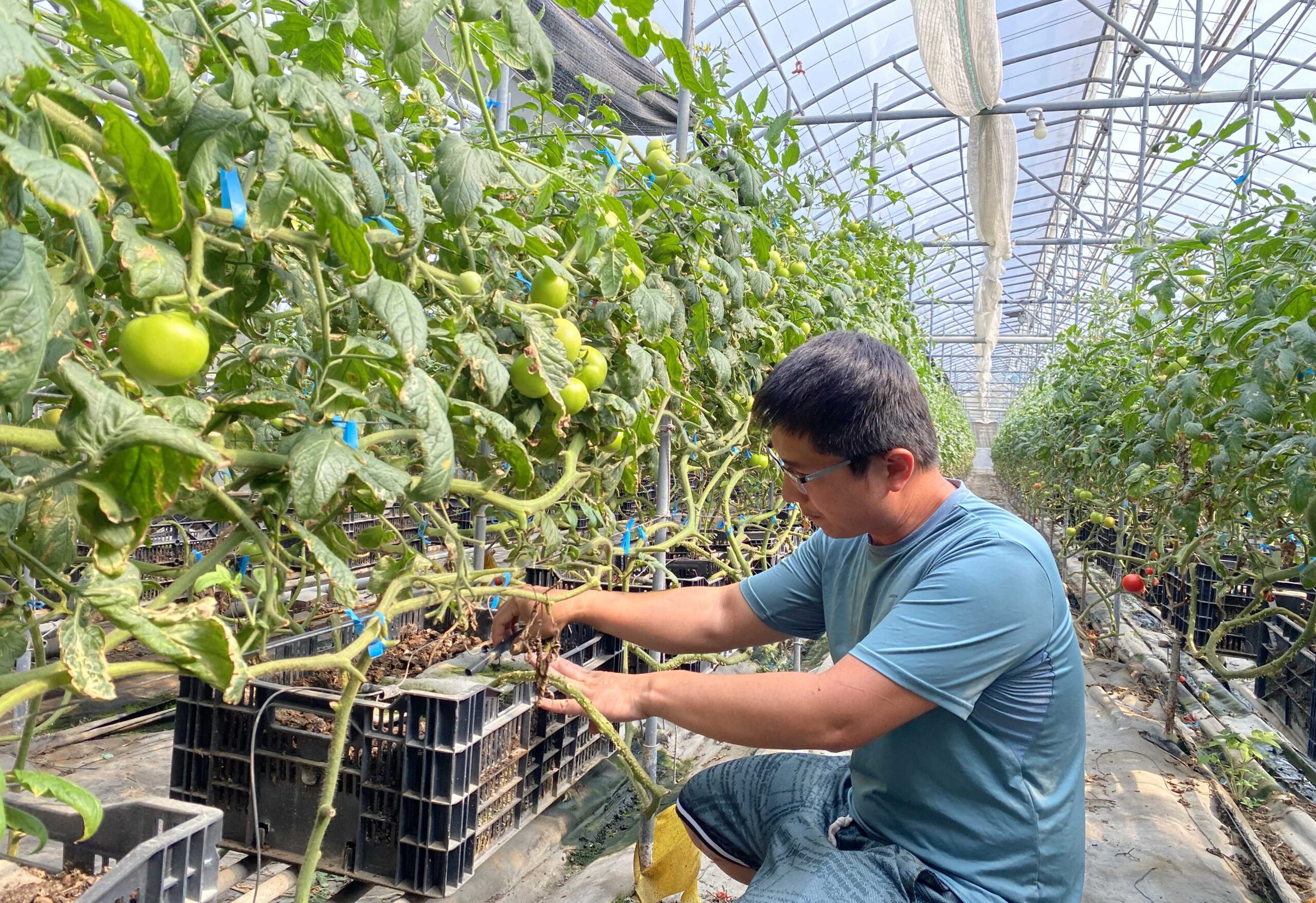Reporters/ XIE, XIN-RU, CHEN, CHI-HAN
What is your first impression of farmers? Is it a job that relies on the weather or hard manual labor? With the advancement of technology and the pursuit of sustainable agriculture, Taiwan’s agriculture is entering a new era. People are now seeking new agricultural technologies and innovative methods, using them to replace manual labor, increase agricultural productivity, and improve the quality of their products. The emergence of “high-tech farmers” has changed the stereotypical impression of farmers being solely reliant on hard work. Nowadays, sweat is no longer the only defining characteristic of this job.

Young people Returning to Hometown in Central Taiwan
Throughout the rural district of Shuilin in Yunlin County, one can see numerous greenhouses along the country roads. A young man in his thirties named Huang,Yan-xun is inside one of them, making full use of various sophisticated instruments. In fact, this high-tech, non-toxic vegetable farm greenhouse is his brainchild. Huang has a master degree in biotechnology, but didn’t choose to become a well-paid researcher and live in the city after completing his studies. Instead, he returned to his hometown to take over his grandfather’s farmland. Witnessing the mass migration of rural populations in Taiwan, Huang decided to utilize Unmanned Smart Agricultural Equipment (USAE), hoping to achieve maximum agricultural production with minimal manpower, thus solving the problem of labor shortage in agriculture. However, building a complete intelligent system independently was not an easy task, especially when he lacked background knowledge in engineering. Fortunately, he has a brother who is an engineer and a friend who is willing to cooperate with him. Using his own expertise in biotechnology, Huang came up with the perfect parameters between crops and microorganisms. Combining programming languages with biological system controls, Huang and his group were able to design one of the most suitable automation systems for each crop.

However, the development of various professional equipment requires enormous capital. Thus, funding has become the biggest problem for Huang to start a business. Although the government had a loan subsidy program for young farmers, it was too difficult to implement in local agricultural associations, which prompted him to protest to a Yunlin legislator. It was this outburst that made higher-level officials visit his farm and truly see how difficult it is for local young farmers to obtain loans. After this incident, the government established a direct line for young farmers in Taiwan to connect with the central government, not only solving Huang’s personal problems but also addressing the plight of young farmers across Taiwan.
Science and Technology Replacing Manpower No Longer a Dream
Huang’s automated agricultural equipment can be divided into two categories. The first is an environmental control system that uses environmental sensors to detect data such as temperature, light, and humidity to assist in stabilizing management of agricultural production areas, allowing crops to be always in an optimal growing environment. This technology reduces the impact of climate change on crops and breaks the stereotype that farmers have to “rely on the weather” for their livelihood.
Secondly, an automated nutrient solution system that uses computers to calculate the fertilizers and elements required by various crops in the soil helps to adjust the proportions for each crop and automatically performs drip irrigation and fertilization at the most appropriate time. In addition to achieving more precise control over crop growth and preventing pest infestations, the use of automated systems can significantly reduce labor costs and increase yields.
Moreover, in order to make more accurate weather predictions, Huang, Yan-xun has set up a small weather station by himself, which, together with the two automated agricultural equipment, monitors the environmental conditions at all times.

Is High-Tech Farming Too High a Standard?
The labor shortage problem in Taiwan’s agricultural industry is not only limited to Huang’s hometown, but is a structural problem in the country’s agriculture. “While the use of technology to assist farmers in their work is necessary, becoming a high-tech farmer is a major challenge. Having a high education level is not the key factor, but sufficient funds are necessary. Farmers also need to improve their basic background knowledge,” Huang, Yan-xun said. Therefore, he hoped that the government could provide subsidies and education to independent farmers in Taiwan.
During the harvest season, a stroll through the fields in Taiwan may reveal not only middle-aged farmers but also elderly people toiling among the crops. The Council of Agriculture’s 2022 statistics show that the elderly population over the age of 65 accounts for as much as 20% of the agricultural population. As a result, Taiwan’s agriculture is facing the problem of an aging workforce and labor shortage.
Although agriculture is one of Taiwan’s important industries, many older farmers still need to work the land due to limited job opportunities in rural areas. Independent farmer Xie, Jun-liang said, “Young people usually think that our work is too laborious, because we have to toil in the fields.” As a result, many young people choose to leave rural areas for cities in search of work. Huang believed that agriculture must move towards mechanization and automation to reduce the need for labor.
In order to encourage young people to return to their hometowns to work in the fields, Huang, Yan-xun has taken the first step by training young farmers. He has personally established a youth training center, teaching young people basic knowledge of crops, cultivation and management techniques, semi-automated agricultural systems, and knowledge of remote monitoring systems. Through cooperation, technology introduction, innovative services and management, he aims to increase the economic benefits and income of farmers, creating a friendly environment to increase young people’s willingness to stay in rural areas. “If their income is as good as, or even better than what they can earn in the city, they will naturally not leave their hometowns to find work. This will solve the problem of population outflow. If people stay, rural areas can sustainably develop,” Huang stressed.

Sharing Economy to Ensure Brighter Future for Taiwan’s Agriculture
In addition to using smart agriculture management equipment and greenhouse cultivation to improve accurate control of crop conditions, Huang, Yan-xun also trained young farmers and collaborated with local independent farmers to help develop Yunlin Shuilin Township into a comprehensive sharing economy.
Due to Taiwan’s small land and traditional family division, many independent farmers lack competitiveness. Huang established a youth training station to share his agricultural knowledge with other local young farmers and help them better manage their land. In addition, he introduced sales channels for agricultural products so that everyone can share resources.
By cooperating with young farmers to expand crop production, sellers are more willing to purchase agricultural products. Moreover, division of labor can be used to control different production periods of each farmland. Unlike in the past where crops can only be concentrated in one or two production periods, nowadays, they are able to solve the problem of not being able to supply tomatoes and cucumbers for customers, and can ensure that there is always a sufficient quantity of goods. “Combining everyone’s strength can make one plus one greater than two,” Huang said.

Huang believed that as long as the land is well managed, agriculture, which was once considered a disadvantage, can become an advantage. During his free time, he took his students to visit agricultural-related research institutes, industry innovation research and development centers, university-related departments, and agricultural small and medium-sized enterprises to learn about agricultural-related knowledge and enhance the competitiveness of farmers, thus promoting the overall progress of rural areas.
As an ancient Chinese poem goes, “Ample rainfall makes the highland glistening white, in rushy rain capes, peasants begin plowing at midnight. When both men and cattle are totally exhausted, in the east there is not yet a glimmer of light,” the emergence of high-tech agriculture can help alleviate farmers’ suffering from unpredictable weather and change the traditional farming models. The integration of smart equipment and greenhouse farming has indeed opened up a new path for agriculture, enabling farmers to have greater control over their crop growth.





